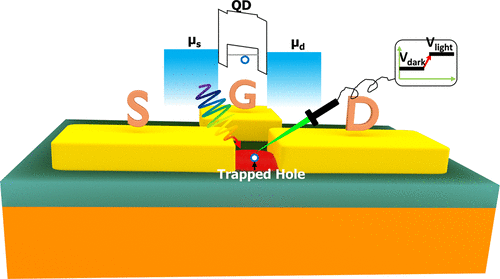当前位置:
X-MOL 学术
›
ACS Photonics
›
论文详情
Our official English website, www.x-mol.net, welcomes your feedback! (Note: you will need to create a separate account there.)
Detecting Single Photons Using Capacitive Coupling of Single Quantum Dots
ACS Photonics ( IF 7 ) Pub Date : 2018-03-09 00:00:00 , DOI: 10.1021/acsphotonics.7b01515 Yang Zhang 1 , Yang Wu 2 , Xiaoxin Wang 3 , Lei Ying 4 , Rahul Kumar 2 , Zongfu Yu 4 , Eric R. Fossum 3 , Jifeng Liu 3 , Gregory Salamo 2 , Shui-Qing Yu 1
ACS Photonics ( IF 7 ) Pub Date : 2018-03-09 00:00:00 , DOI: 10.1021/acsphotonics.7b01515 Yang Zhang 1 , Yang Wu 2 , Xiaoxin Wang 3 , Lei Ying 4 , Rahul Kumar 2 , Zongfu Yu 4 , Eric R. Fossum 3 , Jifeng Liu 3 , Gregory Salamo 2 , Shui-Qing Yu 1
Affiliation

|
Capturing single photons through light–matter interactions is a fascinating and important topic for both fundamental research and practical applications. The light–matter interaction enables the transfer of the energy of a single photon (∼1 eV) to a bound electron, making it free to move either in the crystal lattice or in the vacuum. In conventional single photon detectors (e.g., avalanche photodiodes), this free electron triggers a carrier multiplication process which amplifies the ultraweak signal to a detectable level. Despite their popularity, the timing jitter of these conventional detectors is limited to tens of picoseconds, mainly attributed to a finite velocity of carriers drifting through the detectors. Here we propose a new type of single photon detector where a quantum dot, embedded in a single-electron transistor like device structure, traps a photogenerated charge and gives rise to a sizable voltage signal (∼7 mV per electron or hole by simulation) on a nearby sense probe through capacitive coupling (with a capacitance ∼ aF). Possible working modes of the proposed detector are theoretically examined. Owing to a small lateral dimension of the quantum dot, detailed analyses reveal that the intrinsic timing jitter of the proposed detector is in the femtosecond to subpicosecond range, and the intrinsic dark count rate is negligible up to moderately high temperatures. These figures of merit are orders of magnitude superior to those of the state-of-the-art single photon detectors work in the same spectral range, making the proposed detector promising for timing-sensitive and quantum information applications.
中文翻译:

使用单量子点的电容耦合检测单光子
通过光-质相互作用捕获单个光子对于基础研究和实际应用都是一个引人入胜的重要课题。光与物质的相互作用使单个光子(〜1 eV)的能量转移到结合的电子上,使其在晶格或真空中自由移动。在常规的单光子检测器(例如雪崩光电二极管)中,此自由电子触发载流子倍增过程,该过程将超弱信号放大到可检测的水平。尽管它们很流行,但是这些常规检测器的定时抖动被限制在几十皮秒内,这主要归因于通过检测器漂移的载流子的有限速度。在这里,我们提出了一种新型的单光子探测器,其中的量子点嵌入在类似器件结构的单电子晶体管中,捕获光生电荷,并通过电容耦合(电容约为aF)在附近的感应探头上产生可观的电压信号(每个电子或空穴模拟约为7 mV)。理论上检查了所提出的探测器的可能的工作模式。由于量子点的横向尺寸较小,详细分析表明,所提出的探测器的固有定时抖动在飞秒至亚皮秒的范围内,而在中等高温下,固有的暗计数率可以忽略不计。这些品质因数优于在相同光谱范围内工作的最新技术的单光子探测器,使所提出的探测器有望用于对时间敏感的量子信息应用中。
更新日期:2018-03-09
中文翻译:

使用单量子点的电容耦合检测单光子
通过光-质相互作用捕获单个光子对于基础研究和实际应用都是一个引人入胜的重要课题。光与物质的相互作用使单个光子(〜1 eV)的能量转移到结合的电子上,使其在晶格或真空中自由移动。在常规的单光子检测器(例如雪崩光电二极管)中,此自由电子触发载流子倍增过程,该过程将超弱信号放大到可检测的水平。尽管它们很流行,但是这些常规检测器的定时抖动被限制在几十皮秒内,这主要归因于通过检测器漂移的载流子的有限速度。在这里,我们提出了一种新型的单光子探测器,其中的量子点嵌入在类似器件结构的单电子晶体管中,捕获光生电荷,并通过电容耦合(电容约为aF)在附近的感应探头上产生可观的电压信号(每个电子或空穴模拟约为7 mV)。理论上检查了所提出的探测器的可能的工作模式。由于量子点的横向尺寸较小,详细分析表明,所提出的探测器的固有定时抖动在飞秒至亚皮秒的范围内,而在中等高温下,固有的暗计数率可以忽略不计。这些品质因数优于在相同光谱范围内工作的最新技术的单光子探测器,使所提出的探测器有望用于对时间敏感的量子信息应用中。


























 京公网安备 11010802027423号
京公网安备 11010802027423号